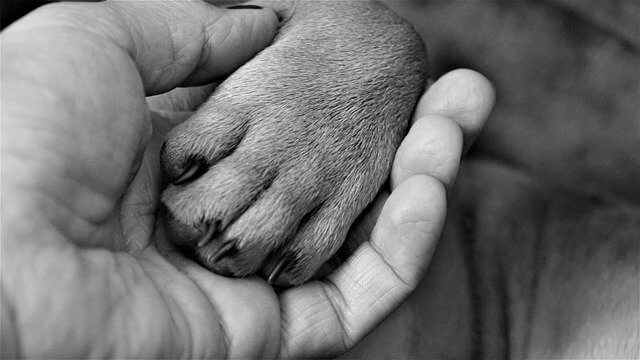What Is Interdigital Cysts in Dogs & How To Help Your Dog
23.03.2022.
Dogs often lick their feet out of boredom, but excessive paw licking signifies that something is wrong. And if you notice redness and rawness between your dog’s toes, this could be a sign of an interdigital cyst. If you've noticed your dog acting strangely or licking their paws excessively, here's what you should know about interdigital cysts in dogs.
What are interdigital cysts in dogs?
"Interdigital cyst" is not a term most people hear every day. However, the name might ring a bell if you're a dog owner. The term is used to describe various conditions that can affect a dog's paws, such as a nodule or large bump that develops between the dog's toes. These lesions are chronic, which means they last a long time and may even recur after being successfully treated.
RELATED: Do Dogs Have Dominant Paws
What causes interdigital cysts in dogs?
Any irritation or injury to the paws' haired skin can result in "plugged," or dilated, hair follicles. These dilated follicles then develop into nodules, which are prone to rupture, causing additional irritation and skin infections. When a dog develops interdigital cysts, it's critical to consult with your veterinarian to determine the cause. Several factors may be at work, including:
1. Coat type
Dogs with short, coarse hair may be more prone to inflamed and ruptured follicles. English Bulldogs, Great Danes, Basset Hounds, Mastiffs, Bull Terriers, and Boxers have this coat type.

2. Paw form
Dogs with wider paws may be more prone to putting weight on the haired skin between the pads. Labrador Retrievers, English Bulldogs, German Shepherds, and Pekingese are examples of breeds with this paw shape or conformation.
3. Obesity
Overweight dogs may put more pressure on their interdigital spaces or the spaces between their toes when walking. You can read more about obesity here - Obesity in dogs.
RELATED: 7 Ways to Clean and Care for Your Dog’s Paws
4. Walking issues
Dogs with arthritis or other joint problems may put more pressure on the interdigital spaces when walking.
5. Licking and other itch-related behavior
Dogs who lick or chew on their paws can cause hair and skin irritation, resulting in interdigital cysts. Diagnosis and management of the underlying cause of itching, such as allergies, is part of treating and preventing interdigital cysts in these dogs.
6. Environment
Skin trauma from crates or rough ground can harm hair follicles.
Secondary infections
Bacterial infections worsen the symptoms, resulting in an acute event where the cyst ruptures and exudes purulent exudate. Mixed infections with Streptococcus and gram-negative species such as E. coli, Pseudomonas spp., and Proteus spp. are most commonly implicated. Malassezia and other fungal organisms may also play a role in the lesions' persistence.

RELATED: Best Dog Boots
What are the symptoms of interdigital cysts?
Interdigital cysts appear as a swollen, red bump between the toes. Despite the fact that interdigital cysts occur on haired skin, you may notice hair loss on or around the swelling. Due to pain, dogs with interdigital cysts may limp on the affected foot. They may lick and chew on the affected area as well. The most common symptoms of interdigital cysts in dogs are as follows:
- Redness
- Inflammation
- Constant paw licking
- Bleeding
- Cysts
- Fluid/pus discharge
- Hairless areas between the toes
- Red bumps
How do vets diagnose them?
Because many other skin conditions can cause nodules on a dog's paws, your veterinarian may need to take skin samples to diagnose and treat them. These skin conditions include Demodex mite-caused demodicosis or demodectic mange, skin cancers, and fungal infections. Here are some of the things a vet might ask for:
- A look at the dog's medical history
- The paws examination
- A skin biopsy will be performed.
- Thyroid disease is detected through a blood test.
- Testing for allergies
How are interdigital cysts in dogs treated?
Many infected dogs require antibiotics. Your veterinarian may collect a skin sample for a skin culture (bacterial culture and sensitivity) to determine the best antibiotic. Anti-bacterial shampoos can also aid in the treatment of a skin infection. If the paw swelling is severe, an anti-inflammatory medication may be prescribed to reduce the swelling and pain. Your veterinarian may also recommend surgical procedures or protective footwear.
Your veterinarian will also collaborate with you to determine the source of the interdigital cysts. If the underlying causes are not identified and treated, they may reoccur, causing scarring and difficulty walking. Diagnosis of the cause of your dog's symptoms can reduce the need for medications such as antibiotics and make your pet more comfortable.
RELATED: Dog Nail Clippers You Must Have
Can they be prevented?
Interdigital cyst prevention necessitates addressing the underlying cause of a dog's cysts. If your dog's interdigital cysts are caused by trauma, your veterinarian may advise you to change your dog's walking surface to reduce paw irritation.
Interdigital cysts caused by allergies necessitate aggressive allergy management in the dog, such as maintenance medication or hyposensitization therapy. Obese dogs may benefit from weight loss, and dogs with mobility issues may benefit from osteoarthritis treatment. Consult your veterinarian to determine the best preventative measures for your dog to avoid interdigital cysts.
World Dog Finder team







Share